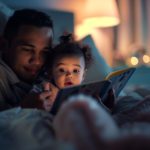
White Noise and Sleep Training for Babies: Does It Help?
Is white noise for babies the secret to successful sleep training? Learn how to integrate white noise into your baby's sleep routine.

Welcome to our guide on white noise for babies and its effectiveness in sleep training.
As parents, ensuring your baby has a restful night's sleep is crucial to ensure a healthy child development—and your peace of mind. But as any parent will tell you, the journey to achieving uninterrupted sleep can be challenging.
This is where white noise comes into play. Could this simple, static-like sound be the key to improving your baby's sleep pattern? Let's take a closer look at white noise, baby sleep training, and how to seamlessly integrate it into your baby's bedtime routine.
Understanding Sleep Training
Sleep training is about helping your baby learn to fall asleep and stay asleep independently. It’s possible from the age of about 4-6 months of age, once a baby has developed a circadian rhythm that makes it possible for them to sleep all the way through the night.
There are several sleep training methods out there, including the cry-it-out method, the chair method, and the Ferber method. Each method has its merits and considerations, but the ultimate goal is the same: signaling to your baby that it’s time to wind down and rest, fostering good sleep habits, and encouraging your child to self-soothe if they wake up during the night.
The Role of White Noise in Sleep
- White noise (noun)
a) a heterogeneous mixture of sound waves extending over a wide frequency range
b) a constant background noise
(Merriam Webster)
When you play white noise to your baby, it provides a soothing backdrop that can calm them and reduce the chances of being startled awake. It’s not only babies that can benefit—adults may also sleep more soundly with white noise playing.
Research shows that white noise for babies can mimic the comforting sounds of the womb, promoting a sense of security and relaxation. A 1990 study that studied 40 newborn babies found that 80% were able to fall asleep after just five minutes of hearing white noise. This suggests it’s definitely worth a try if you’re trying to get your child to sleep right through.
Benefits of White Noise for Baby Sleep Training
Masks Other Noises
White noise creates a consistent sound environment that drowns out other noises that might cause babies to stir, like doors closing, music playing, or cars passing by. It offers a quieter and more controlled sleep environment, reducing the likelihood of sleep disturbances.
Supports Sleep Training Efforts
When incorporating white noise into sleep training, parents report significant improvements in sleep training success. White noise can easily complement most of the sleep training methods, making it versatile and adaptable to different strategies.
Facilitates Faster Sleep Onset
Scientific studies suggest that white noise helps babies fall asleep more quickly. The steady sound can mimic the comforting, continuous noise of the womb, providing a familiar auditory cue for sleep.
Extends Sleep Duration
Babies exposed to white noise often experience longer, more uninterrupted sleep periods. Longer sleep stretches are crucial for infant development and parental well-being, contributing to a more harmonious household.
Improves Sleep Quality
The consistent background noise of white noise is linked to more restful sleep, promoting better sleep cycles and deeper sleep states. Improved sleep quality supports crucial aspects of development, including brain growth and emotional regulation.
Potential Drawbacks and Considerations
Risk of Dependency
Continuous reliance on white noise may cause your child to become dependent, potentially making it challenging for him or her to sleep without it. You could try incorporating transition strategies to gradually reduce reliance, ensuring your baby can adapt to sleeping without white noise when necessary.
Volume and Hearing Safety
Experts suggest a sound level around 50 decibels, which sounds like a soft shower, to protect the baby's hearing. It’s advisable to regularly check the volume settings on white noise machines or apps to prevent accidental increases that could harm your baby’s hearing.
Attention to Sleep Environment
The effectiveness of white noise can be influenced by the overall sleep environment, including room temperature, lighting, and bedding comfort. To support the best possible sleep conditions for the baby, it’s a good idea to assess and optimize the entire sleep setting.
Monitoring for Behavioral Responses
When you begin to introduce white noise, observe your baby's reactions to it because individual responses can vary. You may need to make adjustments in order to find the most comforting sound type and volume. Be prepared to try different sounds and settings within white noise apps or machines to discover what best helps your baby sleep.
Long-term Considerations
Even though white noise may be helpful in the short term, it’s best to plan for the eventual weaning off. Gradual reduction in white noise usage can be part of transitioning to natural sleep patterns as your child grows and develops.
Seeking Professional Guidance
Consult with pediatricians or sleep specialists if there are concerns about sleep habits or the impact of white noise on sleep quality. Professional advice can provide personalized strategies tailored to the baby’s needs, ensuring healthy sleep development.
How to Implement White Noise in Sleep Training
- Choose a high-quality white noise machine or app that features a variety of soundscapes.
- Introduce white noise gradually, making it a part of your baby's nightly bedtime routine.
- Monitor your baby's response to white noise, adjusting the volume and duration to find what works best for your bundle of joy.
FAQ
How can I safely incorporate white noise into my baby's sleep routine?
Use a baby-safe white noise machine with volume control and timers, keeping the sound at or below 50 decibels. Place the device at a safe distance from the crib and monitor your baby’s response. Pair white noise with a consistent bedtime routine and ensure the sleep area is safe and comfortable to create an ideal environment for rest.
Are there any risks associated with using white noise for my baby?
While white noise can be helpful, it may lead to dependency if used continuously. To prevent this, gradually reduce its use over time. Additionally, ensure the sound is kept at safe levels, around 50 decibels, to protect your baby’s hearing. Complement its use with other elements of a safe sleep environment, like proper room temperature and lighting.
What kind of responses should I keep an eye out for when using white noise with my baby?
Monitor how your baby reacts to white noise. Positive responses include quicker sleep onset, longer sleep duration, and reduced fussiness. Negative reactions, such as signs of overstimulation, discomfort, or trouble falling asleep, may indicate the sound is too loud, too close, or unsuitable. Adjust volume or type of noise accordingly for optimal results.
Can white noise help with colic or fussy babies?
Yes, white noise can provide comfort to colicky babies by simulating the constant sounds of the womb. This familiar sound can help reduce crying and overstimulation, creating a calming environment that supports relaxation and better sleep.
Can white noise machines be replaced with natural sounds?
Yes, sounds like ocean waves, rain, or a fan can be alternatives to white noise machines. These natural sounds provide a soothing environment without artificial repetition. However, white noise machines offer consistent, uninterrupted sound, which can be more effective in noisy environments.
How do I wean my baby off white noise?
Gradual reduction of volume and usage time helps babies transition away from white noise. Introducing alternative sleep cues like bedtime routines, soft music, or comfort objects can create new associations that encourage independent sleep without relying on background noise.

Written by
Georgia Austin
Professionally trained copywriter, editor, and content marketing strategist with over 7 years of experience—working with brands like Nike, Siemens, Toshiba, Tommy Hilfiger, Culture Trip, and Klook.
Download Pillow
Get help
Press & News
Legal
Connect
X (Twitter)
Company
Copyright © Neybox Digital Ltd.



